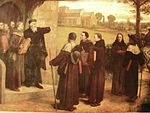Strigolniki

The strigolniki (
The origins of the name remain unclear. Some historians believe it has something to do with handicrafts that the first strigolniki were engaged in, such as cloth-cutting or hairdressing (it appears that the word strigolnik derives from the Russian root strig-, which connotes cutting or trimming). Others think the name comes from a special initiation ceremony (a specific haircut, or strizhka), performed by a deacon named Karp – a supposed founder of the sect (together with deacon Nikita), yet others think it could mean that these people refused to either grow a beard or cut their beards when they entered churches.
Active participants of the sect were tradespeople and low-ranking
Beliefs

There is some debate if the strigolniki were "heretical", if they were a proto-Protestant movement among Orthodox Christians, being similar to Lollardy or the Hussites, or if they merely opposed the priesthood.[7][8] The strigolniki movement has been suggested to have had iconoclastic tendencies, though it is not clear if they came out against the use of icons, it is clearer that they came out against monasticism.[9][10]
The strigolniki opposed the ruling church, refusing to recognize its bishops and priests,[11] and rejected going to Orthodox churches, instead gathering at separate meetings.[12] They are also known to have criticized Orthodox priests whom they called "drunkards".[13] They also repudiated ordainment, believing that simple laymen could perform church service, and the established church rituals.[14] They also criticized the feudal order.[14] The nature of the movement is seen from the words of Stephen of Perm: "Of the strigolniki illiterate people say: those neither steal nor collect wealth".[14]
Karetnikova suggested that the strigolniki were a response to changes in the
M. V. Pechnikov argued that the strigolniki merely rejected the Orthodox priesthood, simony and confession to clergy, while not denying the sacraments of the church nor most dogma.[8]
Obolensky has instead suggested that the strigolniki were born from Bogomil or Cathar missionaries in Russia during the times of Kievan Rus'.[17]
Stephen of Perm mentioned that the strigolniki did not confess their sins to clergy but instead to the ground; however, the meaning of what Stephen meant is not clear.[16][8]
History
According to an epistle by Stephen of Perm, Karp "began to tell the people: it is neither dignified to sing over the dead, nor to mention them; nor to bring offerings for the dead to the church; nor to have feasts; nor to give alms for the soul of the departed".[14]
Deacon Karp found many followers in Pskov, but had to move to Novgorod to avoid
In 1375, enraged citizens of Novgorod threw three heretics from the bridge into the Volkhov River.[18] According to the 16th-century Nikon Chronicle, the justification for this was a literal interpretation of the Gospel (Matthew 18:6): "Whoever causes one of these little ones who believe in me to sin, it were better for him to have a great milestone hung around his neck, and to be drowned in the depths of the sea".[4] The chronicles mention that "the heretic strigolniki were beaten; deacon Nikita and Parishioner Karp and a third man with them were thrown from the bridge".[14]
Stephen of Perm wrote a letter to Nilus of Constantinople in 1382 about the strigolniki.[8]
However, the teachings of the strigolniki lived on. They spread widely in Novgorod, in Pskov, and also in Tver, where
The strigolniki disappeared in the early 15th century due to persecution,[9] as well as due to disagreement among the strigolniki.[3] The last mention of the strigolniki was in 1487.[8]
See also
References
- ^ ISBN 978-0-19-879644-2.
- ^ B. A. Rybakov, Strigolniki: Russkie Gumanisty XIV Stoletiia (Moscow: Nauk, 1993); David M Goldfrank, "Burn, Baby, Burn: Popular Culture and Heresy in Late Medieval Russia," The Journal of Popular Culture 31, no. 4 (1998): 17–32.
- ^ ISBN 978-0-19-534814-9.
- ^ ISBN 978-0-85728-752-6.
- ^ a b N. A. Kazakova and Ia. S. Lur'e, Antifeodal'nye ereticheskie dvizheniia na Rusi XIV-nachala XVI veka (Moscow and Leningrad, ANSSSR, 1955), esp. pp. 34-71.
- ISBN 978-1-5326-1831-4.
- ISBN 978-0-691-22287-5.
- ^ a b c d e "СТРИГОЛЬНИКИ • Большая российская энциклопедия - электронная версия". bigenc.ru. Archived from the original on 2022-10-07. Retrieved 2022-08-21.
- ^ ISBN 978-1-134-92102-7.
- ISBN 978-1-134-92102-7.
in the middle of the fourteenth century the Strigolniki heresy broke out in Russia, chiefly in the cities in the north of the country, which gave this movement a proto-Reformation character
- ^ Petrushko 2019 p. 456.
- ^ Голубинский Е. Е. История русской церкви. Том 2: От нашествия монголов до митрополита Макария включительно. Период второй, Московский. Университетская типография, 1900. — С. 398
- ^ a b Crummey 2014, p. 126.
- ^ ISBN 978-1-5326-1831-4.
- ^ Каретникова М. С., Русское богоискательство. Национальные корни евангельско-баптистского движения
- ^ a b c Petrushko 2019 pp. 456–57.
- ^ Crummey 2014, p. 125.
- ^ Some scholars see this as an execution after the heretics were condemned by Archbishop Aleskei (r. 1359–1388), but others see it as a lynching. See B. A. Rybakov, Strigolniki, 4-11.
Sources
- Crummey, Robert O. (6 June 2014). The Formation of Muscovy 1300 - 1613. Routledge. p. 126. ISBN 978-1-317-87200-9.

